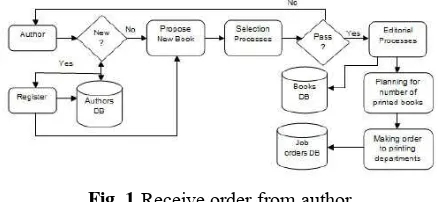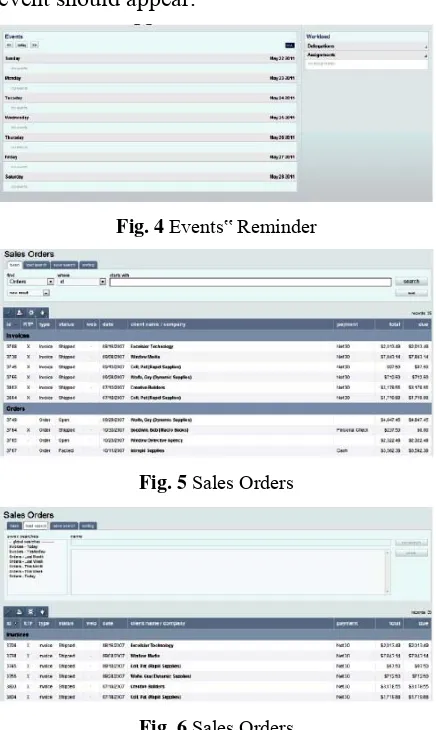for Publishing and Printing Enterprise
Saarce Elsye HataneAccounting Lecturer, Economy Faculty, Petra Christian University Surabaya, Indonesia
Leo Willyanto Santoso
Faculty of Industrial Technology – Informatics Department Petra Christian University
Surabaya, Indonesia [email protected]
Maliheh Gorjian
Faculty of Education Administration , Assumption University Bangkok, Thailand
Abstract- Publishing and printing
businesses, both small-medium enterprise (SME) and big company, run their businesses as manufacturing businesses. Many SMEs still run their businesses with traditional information system which is not integrated. The limitations are limited real time information about the businesses, and management or owner cannot analyze business performance based on trusted and real time data. The objective of this paper is to design an integrated accounting information system for publishing and printing enterprise, especially the SME one. A web-based integrated information system can help the enterprise to get real time and completed information to make business decision, thus the enterprise can maximize its value constellation. By implementing e-commerce module, online ordering and controlling can be handled by this application as well. Overall, this application increased significantly efficiency and effectiveness of the company’s business process.
Keywords- e-commerce, manufacturing information system, publishing and
printing enterprise, value constellation, web-based information system
I. INTRODUCTION
Publishing and printing businesses, both small-medium enterprise (SME) and big company, run their businesses as manufacturing businesses. Many SMEs still run their businesses with traditional information system which is not integrated. The limitations are limited real time information about the businesses, and management or owner cannot analyze business performance based on trusted and real time data. The objective of this paper is to design a web based integrated accounting information system for publishing and printing company, as small and medium enterprise, especially for its sales order and production process in order to increase its value constellation.
compete with traditional print function and performing, produce for e- Business audience attention and provide opportunities efficiencies for publishing and printing (P&P) industries to better communication and as fast as possible [1].
II. MANAGEMENT INFORMATION SYSTEM
Management information system (MIS) is talking about the dynamics of the firm. It shows the capability of a management team in implementing and operating a system with the adapted technology which collects, stores, processes and distributes all internal and external information In real time. Some achievements through MIS are improving productivity; getting rid of distances; redesigning the organization; increasing flexibility; opening up to the firm; and up to speed [2].
III. VALUE CONSTELLATION
Value chain plays the function to integrate information systems from suppliers to customers in order to reduce defects and inventories, speed time to market and improve customer satisfaction. The most complex value chains can be managed via intranets, extranets and proprietary networks. The value constellation is a business space where companies are focusing on their own competencies and share knowledge. Core competency and outsourcing are the keywords [3].
IV. INFORMATION SYSTEM in PUBLISHING and PRINTING
COMPANY
Publishing is the process of production and distribution of literature as information to the general public. Now days the scope of publishing has expanded, not just printed resources, but also electronic resources. Steps in publishing process started with editorial stage. Publishers may pay
editors to do copy edit to ensure that the texts match the style and grammatical requirements. For the translated book, publisher may hired translator. Some publishers employ fact checkers regarding non-fiction works. The next step is design stage where the artworks play their function to make the layout and typesetting. It also includes proofreading, dust jacket composition, specification of paper quality, binding method and casing. If the publishers print and distribute the texts or literatures, they must pay honor to the authors as the royalty.
In fact, now a day because of globalization changes rapidly in economy and information system through all sorts of businesses especially in publishing and printing companies all of the traditional system functions such as slow motion movement (marketing, sales, designing, editing, inside and outside of company communication or International Communication System) are changed. International Technology system (ITS) has made the businesses easier, faster, and low cost functions. In this case, it is necessary to all of publishing and printing companies to renew their traditional operation and integrating to ITS. Thus, all businesses such as productive and services are needed dynamic information system and management as a team workers to operating for success, business goal achievement, working as a joint venture with others companies, international processes in communication and also remaining in international standard system [4].
chain related to product making process. Production system used in publishing and printing sector is job order system, because each order has its own characteristic.
First activity in the production cycle is product design. Both publishing and printing departments has its own production stage. In the publishing department, management will receive order from authors to publish a new book or literature or from other customers to republish an existing book. In case for the new book, after receive the draft from author, management In this stage will design the layout, design for the cover, character of the letters, animation or picture needed, and do proofreading. Each order will has its own job sheet card. Second step is resources allocation, management will make the production plan, how many working hours needed to complete each process until publishing process completed. Then, management will sent order to printing department. Same as before, management in printing department also will do product design and resources allocation.
Printing department will receive order not just from publishing department, but also from external customers, such as reprint existing book, invitation card, brochures, etc. There is two main documents in product design stage, bill of materials and operation list. Specifications of materials used in production process will be written down in bill of materials (BOM). BOM also used as evidence for the moves of raw materials from warehouse to production department. In operation list (OL), management will write about men and machines used to produce each order. OL also used as evidence for the moves of order to each process.
Production process in printing department will be started from layout department where the staff will edit and make the template/stereotype/film of the order based on customer‟s description. Next, the job will be moved to copy department where the printing plate made. Then, in the cutting department, raw materials (papers
and any other materials) will be cut based on the printing plate. Next is offset (printing) section, the printing plate will be put in the offset (printing) machine which has been given inks according to customer required specifications. If the job is for reprinting, management does not need to make the printing plate. Nowadays, the technology development creates printing machine that doesn‟t need printing plate, we can draw the printing layout and the printer will work just like we do on printing plate. Final stage is finishing. All of printed order will be finished in finishing department. Processes in the final stage are compounding of all printed papers and bookbindery; if it is card, the finishing processes are cutting in to peace of card and packaging.
Costs include in production process are direct materials (any types of papers and inks); direct labors (authors-royalty, editors, proofreaders; labors in production departments); and overhead costs (all indirect costs in production process). All of the product costs will be recorded in job cost sheets per job order.
V. THE WORKFLOWS
Workflow to show the process of receive order from author for new publishing book:
Fig. 1 Receive order from author
Fig. 2 Order moving from publishing to printing department
Workflow to show the order from customers (book stores) for reprint existing book:
Fig. 3 Order from customer for reprint existing book
VI. FORMS
Production plan form. It is used for making the production processes plan from the beginning until the end in order to keep the production processes can be finished on time; bill of materials form, used to record details of materials used in production processes for each job order.
Move ticket. It is used to know the moves of job order from each stage and to make sure that it moves according to the predetermined schedule.
Materials requirement form. It is used to give authorization for the warehouse staff to send out materials to production department.
Order form. It records about customer‟s identification, date of order, required finishing date, and order specifications.
Job cost sheet form. It records about detailed costs in production process (DM, DL, and Overhead).
Working hours form. It records the working hour of each labor/staff in producing each order.
Customers form. It records customer‟s detail such as customer number, name, address, and others personal business data; finished goods form, to record detailed data about finished order.
Finished goods form. It records order has been completely finished. The code of goods, name, description, unit number, and cost per unit.
Materials form. It records the materials provided in warehouse, about the code, name, numbers and cost per unit.
Department form. It records all departments which contribute in production processes and labor cost rate in each department.
Actual overhead costs form. It records the actual overhead costs, such as indirect materials and labor costs, electricity, depreciation of all fixed assets in production departments, etc.
Predetermined overhead costs form. It records estimated overhead costs will be used in order to determine production costs per job order. The estimation can be made based on actual overhead costs on the previous period.
VII. THE IMPORTANCE OF ITS OR ICT MANAGEMENT
As reviewing the three figures, all the functions and operations are needed long time, capital, and capacity for (input, processes, and output product) if the company following the traditional system. But by using ICT will help coworkers to work collaboratively and with confidence more over maximizing their work performance qualities as international standard.
industry. Publishers make possible for successful operation performing in the mobile Internet services marketing, it makes possible to get access for achieving to the customers internationally in short time.
VIII. SCREEN SORT
In this first page (Fig. 4), we have a reminder events which alert us when this event should appear.
Fig. 4 Events‟ Reminder
Fig. 5 Sales Orders
Fig. 6 Sales Orders
In this page (Fig. 5 and 6) we can create new orders and invoices easily. Log multiple client shipping and billing addresses, discount, tax, payment and shipping method. To finalize a sales order each of the following must be completed: client shipping/billing, item pricing, discounts, taxes, payment method.
Fig. 7 Products Page
In this page (Fig. 7), we can create, edit and inactivating the products. When working with large numbers of products, product categories can help you find, sell and report on the products you are interested in.
Fig. 8 Tasks Page
Fig. 9 Events Page
In this page (Fig. 8) you can create a task in this application. Once created, a task will be displayed in the “Assignments” or “Delegations” sections of the snapshot page (Fig.9).
IX. POLICY IMPLICATIONS
However, the Policy implications are important factors for (P&P) industries developments relating to (ITS& ICT) and e-business, which in this mater (P&P) sector automatically involves „media policy' in the wide rang global environment. E-Business which regards the important areas as follow:
the P&P publishing and printing sector as a creator and innovator of public information goods and externalities services. ITS and ICT role is compulsory for anticipating and diversity of opinion and remaining in international standard and competitiveness environment.
REFERENCES
[1] http://ec.europa.eu/enterprise/archives/e-
business-watch/studies/sectors/publishing/documents/Publi shing_2005_II.pdf. accessed May 1, 2011
[2] Romney, Marshall B., and Paul John. Steinbart. Accounting Information Systems. Upper Saddle River, NJ: Pearson Prentice Hall, 2009.
[3] MIS “Managing the Digital Firm” by Kenneth C.Laudon and Jane P.Laudon - 11th edition (International) – Pearson Education – Prenctice Hall


